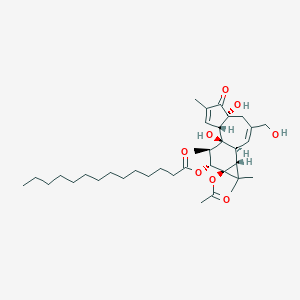| References |
| 1 |
2,3,7,8-Tetrachlorodibenzo-p-dioxin-mediated production of reactive oxygen species is an essential step in the mechanism of action to accelerate human keratinocyte differentiation. Toxicol Sci. 2013 Mar;132(1):235-49.
|
| 2 |
Down-regulation of the expression of alcohol dehydrogenase 4 and CYP2E1 by the combination of alpha-endosulfan and dioxin in HepaRG human cells. Toxicol In Vitro. 2017 Dec;45(Pt 3):309-317.
|
| 3 |
Long-term estrogen exposure promotes carcinogen bioactivation, induces persistent changes in gene expression, and enhances the tumorigenicity of MCF-7 human breast cancer cells. Toxicol Appl Pharmacol. 2009 Nov 1;240(3):355-66.
|
| 4 |
Gene expression changes in human small airway epithelial cells exposed to Delta9-tetrahydrocannabinol. Toxicol Lett. 2005 Aug 14;158(2):95-107.
|
| 5 |
Two persistent organic pollutants which act through different xenosensors (alpha-endosulfan and 2,3,7,8 tetrachlorodibenzo-p-dioxin) interact in a mixture and downregulate multiple genes involved in human hepatocyte lipid and glucose metabolism. Biochimie. 2015 Sep;116:79-91.
|
| 6 |
New insights into BaP-induced toxicity: role of major metabolites in transcriptomics and contribution to hepatocarcinogenesis. Arch Toxicol. 2016 Jun;90(6):1449-58.
|
| 7 |
Methylated pentavalent arsenic metabolites are bifunctional inducers, as they induce cytochrome P450 1A1 and NAD(P)H:quinone oxidoreductase through AhR- and Nrf2-dependent mechanisms. Free Radic Biol Med. 2014 Feb;67:171-87.
|
| 8 |
Transcriptional activation of the human Cu/Zn superoxide dismutase gene by 2,3,7,8-tetrachlorodibenzo-p-dioxin through the xenobiotic-responsive element. Mol Genet Genomics. 2001 Sep;266(1):133-41.
|
| 9 |
The transcriptional activation of the human copper/zinc superoxide dismutase gene by 2,3,7,8-tetrachlorodibenzo-p-dioxin through two different regulator sites, the antioxidant responsive element and xenobiotic responsive element. Mol Cell Biochem. 2002 Nov;240(1-2):47-55.
|
| 10 |
The transcriptional signature of dioxin in human hepatoma HepG2 cells. Biochem Pharmacol. 2000 Oct 15;60(8):1129-42.
|
| 11 |
The Ah receptor regulates growth factor expression in head and neck squamous cell carcinoma cell lines. Mol Carcinog. 2014 Oct;53(10):765-76.
|
| 12 |
Pathogenesis of aryl hydrocarbon receptor-mediated development of lymphoma is associated with increased cyclooxygenase-2 expression. Am J Pathol. 2007 Nov;171(5):1538-48.
|
| 13 |
Aryl hydrocarbon receptor-ligand axis mediates pulmonary fibroblast migration and differentiation through increased arachidonic acid metabolism. Toxicology. 2016 Aug 31;370:116-126.
|
| 14 |
Comparison of HepG2 and HepaRG by whole-genome gene expression analysis for the purpose of chemical hazard identification. Toxicol Sci. 2010 May;115(1):66-79.
|
| 15 |
Comparison of phenotypic and transcriptomic effects of false-positive genotoxins, true genotoxins and non-genotoxins using HepG2 cells. Mutagenesis. 2011 Sep;26(5):593-604.
|


